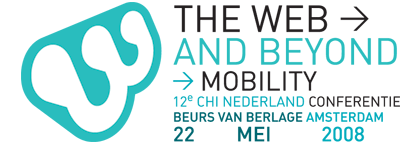Thursday May 22 2008 I visited the CHI conference The Web and Beyond: Mobility in Amsterdam. Keynote speakers were: Adam Greenfield (Everyware); Jyri Engeström (Jaiku); Ben Cerveny (Playground foundation, Flickr); Christian Lindholm (Fjord, Nokia).

I was particularly impressed with Adam Greenfield‘s presentation. He had a very rich and dense talk based on the material of the book he is currently working on called “the city is here for you to use”. Below some notes about his talk.
Greenfield starts by stating his affiliation with the urbanist tradition of Jane Jacobs and others, who see the city made up of bottom-up processes by ‘ordinary people’. He then described the current state of the city. The (American) city nowadays is characterized by repetition, deliberate attempts to make certain public spaces less attractive to dwell in, and a lot of junk space and privatized commons [although Martijns’ recent post shows how these kind of spaces are re-appropriated by kids].

(photo made by Antje Roestenburg)
The result, Greenfield says, is a withdrawal of people into mobile phone’s private spaces. The challenge is to overcome these threats to urban life – “the crisis of the American city” – by refinding what constitutes the city in Jacobs’ tradition. Greenfield tries to find that answer in ubiquitous computing. Networked processors are already showing up in new places, on the level of bodies and on the level of the streets. These become social objects. They help create an “ambient informatics”: delivering information locally upon which you can act. This really becomes ambient when information processing dissolves into behavior. Greenfield gives an example of a woman he saw using her transit card in public transport by swinging her handbag in full speed in front of the reader, almost becoming a choreography.
Architecture and building is becoming increasingly shaped by computation. It changes the city-scape. It changes mobility too. Objects become accessible, scriptable, queryable, and connected. All this changes the way we use cities from browsing to searching. We can now directly look for something and this search can be customized by recombining elements.
Greenfield is somewhat critical of all kinds of informational mapping projects such as the Oakland crime map. People have started to how up at the precinct with such maps demanding more police presence! So are these maps really representing actual risks on the streets, or are they misleading? There are other things more likely to kill you than street crime.
Greenfield goes on to talk about “the big now” and “the long here”. He talks about Twitter, and how it is used to become immersed in other places at the same time. This changes city life. Greenfield calls this “The Big Now”. But places are also accessible from multiple other places. Greenfield calls this “The Long Here”: you don’t enter a place, you enter a time.
Another thing we should be critical of is “differential permissioning”, the way technologies are used to differentiate people into allowed access or denied access to certain places based on predefined characteristics (this is what Graham calls “the software sorted city”). What is happening to public space? Formerly, everyone had the right to use pavements, parks, etc. We’re moving away from guaranteed availability and access, to differential access. [But hasn’t urban space always been differentiated? For example the ghetto vs. the theater, each barring off groups of people that ‘do not belong there’.]
We have to keep in mind that cities are not all the same, but all have their own particularity. We also have to take into account unexpected emerging behavior. These “ambient informatics” objects may be hackable and even used for dangerous/bad ends.
Greenfield ends with some “proposals for the real time city” that urban/media designers should leep in mind:
1. Create beautiful seams: read/write access to city
2. Underspecify: do not too much closure to space.
3. Understand changing city life: from flaneur to consumer to user.

2 responses to “The Web and Beyond: Mobility (1) – Adam Greenfield”
Being critical of showing crime incident data gives me concern. Spotcrime.com efforts to map crime across the US is not an attempt to editorialize or sensationalize crime. We feel that crime incident data should be publicly available. I see no acceptable argument to obscure information from the public.
Hi Colin, you’re right, there is no reason this kind of information should be obscured from the public. But I think the point Adam Greenfield tries to make in his talk – and which I could have conveyed more clearly here – is that it should be very clear what is actually mapped: crime incidents, not actual risk. For instance: at the same spot the risk of getting run over by a car, getting killed by environmental hazards or a domestic accident could be much higher.
Also, many of these maps lack contextual information such as: what ‘type of person’ was there (demographics)? How did he/she behave? Was there any cause or event leading up to the crime? Is there a high concentration of jewellers in that particular street? Have the street lights just fallen out? Have the police being called away to another neighborhood? Etc. etc.
This isn’t to say there is no worth in these kind of crime-mapping efforts. I guess – in short – the point is maps tend to show only what they are made for, while we should also be aware of what isn’t shown by maps. Statistically, it could be much safer to live in a neighborhood with a high crime rate than living in a neighborhood where many people drive big Hummers…